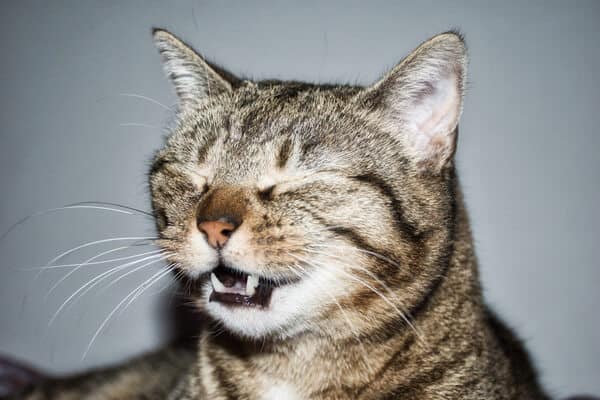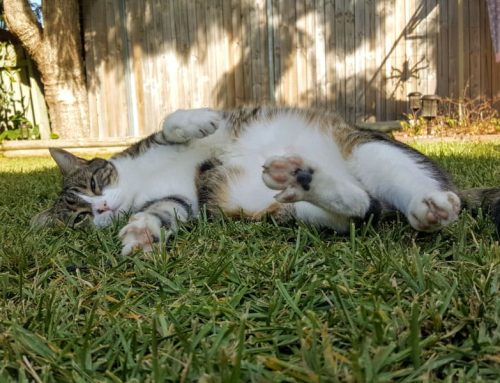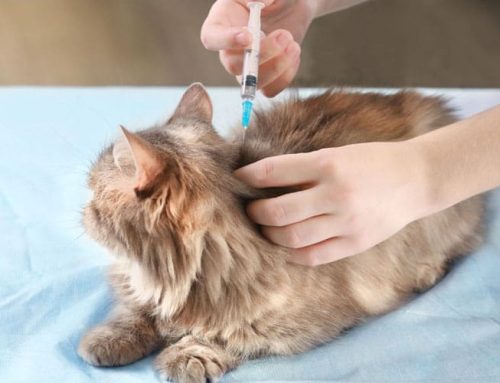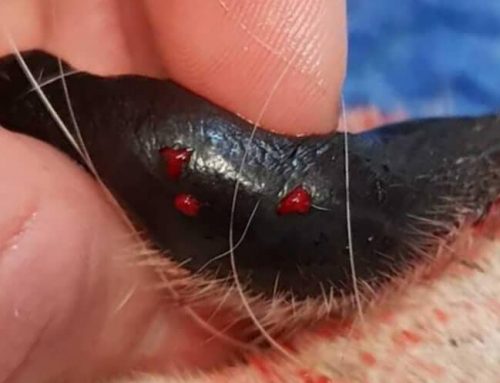Why Is My Cat Sneezing A Lot? When Do I Need To Worry?

[easy-social-share]
Bless you! We’ve all heard the sound of a cat sneezing – gosh they sound cute!
But, when do we need to worry about a sneezing cat?
When is a sneeze, not just an irritating tickle but a sign of something more ominous?
In this article, we will help you to decide when you need to seek expert vet advice.
Why Do Cats Sneeze?
Just like us, our cats can sneeze for a myriad of different reasons.
Sneezing is a completely normal response to irritation of the nasal cavity – something we definitely want to be functional.
Potential reasons that a cat is sneezing include:
- A simple irritation or tickle to the nose from dust or other airborne particles – this may induce a sudden flurry of frequent sneezes that then settles.
- The presence of a foreign object such as a slither of grass, hair or string – your kitty may not constantly sneeze, but they may sneeze a couple of times a day.
- A respiratory infection – this could be either viral, bacterial or fungal
- An allergic response
- Inflammation of the nasal passage or sinus cavity
- Infection of the sinus (primary or secondary i.e. from an infected tooth)
When Do I Need To Talk To A Vet?
The occasional sneeze from time to time shouldn’t set off any alarm bells (apart from maybe motivating us to vacuum a little more regularly), but if you find that your feline friend is sneezing every day or has a discoloured discharge, or is unwell. then it’s probably time to have a chat to the professionals.
To help prepare for a talk to a vet we recommend that you keep a diary of events so that you and the vet can look for patterns.
This can help to determine if there is a trigger.
Otherwise, if sneezing is associated with your cat being more lethargic or going off their food then this can be an indicator that your cat is systemically unwell and that you definitely must talk to a vet.
It can pay to ask yourself the following questions:
- Where was your cat when the sneezing occurred?
- Was there a candle or incense burning? Or any other strong smells?
- Did your cat have access to long grass, a sewing kit, or fishing equipment recently? ‘
- Has there been a change to your cleaning routine or products used?
- Has your cat been in contact with any other cats? In a cattery? Maybe you have a new kitten?
- Is there any eye discharge?
- Is there any nasal discharge and what colour is it?
- Does there appear to be any facial swelling?
- Does the mouth smell or are there other signs of dental disease?
The answers to these questions may highlight a possible cause.
Common Symptoms That May Be Seen With Sneezing
Nasal Secretions/discharge
Because a sneeze is meant to clear the nasal passages, any increase in the amount of nasal secretions will elicit a sneeze.
For most young cats and kittens, acute sneezing is usually a result of an upper respiratory infection (URI).
These infections are commonly caused by cat flu – a general term for a highly contagious upper respiratory disease caused by one or more viruses including Feline Herpesvirus 1 (FHV1) and Feline Calicivirus (FVC).
We recommend cat vaccinations to protect your kitties against these respiratory viruses.
While the initial nasal congestion could be due to a viral infection, occasionally these progress with a secondary bacterial infection that can lead to pneumonia or a nasty nasal sinus infection, so caution is always necessary.
Rarely, an increase in nasal infections could be due to a fungal infection. These can be particularly nasty and we often see blood in the secretions in cases caused by fungus.
If you are concerned that your cat is suffering an infectious cause of sneezing, then veterinary care is advised.
Rotten Teeth
Sometimes a nasal secretion can be pus – from having rotten teeth.
If we’ve been a little blase with ensuring that our cats receive regular dental healthcare such as feeding a special dental food, dental treats or toothbrushing, and a regular scale and polish at the vets, then it’s possible that teeth can become infected.
When a dental infection isn’t treated, the bone between the hard palate and nasal cavity starts to wear down, and eventually, pus from the gums can enter the nasal cavity.
We call this an oronasal fistula and it is a problem that will require surgery to fix.
If you notice that your cat’s breath is smelling a little funkier than usual and there is a nasal discharge or swelling on one side of their face, a trip to your vet may next be on the books.
Foreign Particles/Bodies
Dirt, dust, household cleaning products, pollen, blades of grass and seeds can enter the nasal cavity and trigger extreme and violent sneezing episodes.
Occasionally, the cat won’t react with continuous sneezing but will develop a runny nose and intermittent sneeze.
Whilst dust and many similarly minute-sized particles will be expelled, larger objects do tend to get stuck and necessitate surgical retrieval at a vet – usually with an endoscope, similar to those used for people.
In some parts of the world, Cuterebra larvae are found in the nasal passages of cats and need removing.
Watch the video below to see a Cuterebra larvae being removed from a kitten’s nose.
Polyps
There are two types based on where they are found:
- nasal
- nasopharyngeal polyps
Nasal polyps tend to be more common in younger animals while nasopharyngeal polyps are more likely found in older animals.
Whilst the type of sneeze (reverse or normal) can provide clues on where this polyp may be (nasal passages, or soft palate and even the ear canal!), other clinical signs may help point us in the right direction.
Nasal polyps can cause chronic nasal discharge, congestion and noisy breathing, whilst nasopharyngeal polyps (because they’re further back) can cause neurological signs, a change in voice and even retching.
Whilst radiographs may sometimes pick up the presence of polyps your vet is likely to suggest a thorough exam of the nose and pharynx under general anaesthesia, occasionally using a scope to assist with visualisation.
The following video shows the removal of a nasal polyp in a cat and was kindly shared with us by the Animal Health Centre of Melville P.C. Ltd.
Neoplasia
From the Greek for “new growth” (neo = new, plastic = moulded), in unfortunate circumstances, sneezing can also be indicative of a cancerous growth within the nasal passages.
More often than not, this is also accompanied by noticeable swelling and asymmetry of the face, pain and possibly even blood.
Extra-Nasal Causes
In this situation, sneezing is due to secretions being expulsed up into the nasal passages, usually due to pneumonia, reflux or chronic vomiting.
Often the discharge has a putrid smell and look of vomit that helps to distinguish a potential cause.
But ultimately, the clinical workup will involve a lot more investigation.
Allergies
Unlike people, allergies causing sneezing are not very common in cats. But when they do cause a problem we see signs of watery eyes, a runny nose, sometimes itchy skin and of course, the sneeze.
Working out the trigger is vital and keeping a diary of events as discussed earlier in this article will help immensely.
What To Do If Your Cat Is Sneezing
In general, the vast majority of cases of sneezing occurs because of cat flu (viral infection).
In these cases supportive treatments are required.
If your cat has a nasal discharge, wipe their nose daily with a warm, moist cloth to clear the discharge.
If their eyes are weeping, wipe this discharge away too.
Use a humidifier to keep the air moist to assist with loosening the discharge. You can do this by putting your cat in the bathroom with you while having a hot shower.
If your cat has a loss of appetite, tempting them to eat is very important. Adding a little fluid to the food and heating it can encourage eating.
Make sure your cat has access to plenty of water.
In general, if your cat is still showing signs of an upper respiratory tract infection after 7 days, then it is time to visit the vet.
Please go to the vet sooner if they:
- stop eating and drinking,
- cannot open their eyes or eyes look ulcerated
- there is blood in any discharge from eyes or nose
Occasionally the stuffy nose or rhinitis will make your cat systemically unwell. This is when you must see the vet and have them assess whether they need:
- Antibiotics
- Eye medications
- Subcutaneous fluids (in cases where they aren’t drinking and are dehydrated)
If a cat is sneezing frequently and they seem well (i.e. doesn’t have cat flu) then it is best to have them checked.
For any cases of on-going nasal discharge, these cats will need to be examined under anaesthesia to facilitate not only a diagnosis but to aid in treatment.
Treatment maybe be as simple as a nasal flush, retrieval of a foreign body or removal of a tooth, to more advanced care.
Most cases of cat sneezing are no cause for worry, but if you are unsure, please get in touch with our vets to get an expert opinion.
[easy-social-share]





Leave A Comment